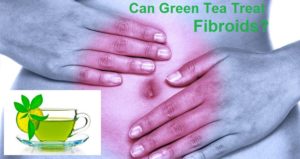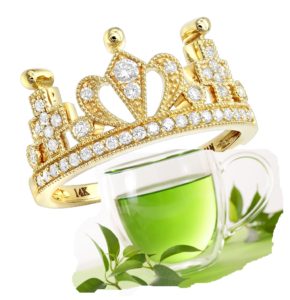
Fibroids are non-cancerous growths that develop in or around the womb (uterus). They’re composed of muscle and fibrous tissue and can vary in size. Sometimes, they’re known as uterine myomas or leiomyomas. The usual treatments, when necessary, are medication or surgery 1. But is it possible that something without any negative side-effects, that is as simple, natural and non-invasive as consuming green tea really be proven to be as or more effective than medication or surgery?
Fibroids can go unnoticed or they can produce mild to severe symptoms, such as:
- heavy/ painful periods
- abdominal/lower back pain
- frequent need to urinate
- constipation
- pain or discomfort during sex
- need for hysterectomy
- various negative effects on pregnancy
- complete infertility 2
One regular feature of those who eat a WFPB diet is that they will drink green tea. It’s something that has been shown again and again to have a wide range of other health benefits 3 4 . But in relation to the specific condition of fibroids, what clinical evidence exists that consuming it can help with fibroids?
A 2013 randomised, placebo-controlled trial 5 took two groups of subjects and gave them either a green tea extract or a placebo. After the test period of 4 months, the results were pretty impressive:
- in the placebo group, fibroid volume increased 24%, which is what is what fibroids do
- in the green tea group, there wasn’t just that there was no increase in the fibroid volume, but there was a reduction. And this wasn’t just by a little bit, it was a dramatic decrease, shrinking by almost one third in size – a “highly significant result.”
There were additional benefits for the green tea group in comparison with the placebo group:
- a dramatic decrease in symptom severity
- significant improvement in health-related quality of life values, month after month
- improved and even reversed blood loss counts (i.e. less risk of anaemia) – blood levels continued decreasing in the placebo group since they had all the continued excess blood loss each month
The results were said by the researchers to be comparable with the results from using the most commonly prescribed drugs (such as Lupron, Synarel and Lysteda), but with the welcome difference that there were zero adverse effects from taking a green tea extract when compared with medications.
These results were also comparable with the surgical procedure called artery embolisation 6 , where surgeons attempt to sever the blood supply to the fibroid without also accidentally slicing the blood supply to the rest of the uterus and causing uterine necrosis 7 , an oft-reported major complication which can also result in death.
The study concludes that green tea extract: “shows promise as a safe and effective therapeutic agent for women with symptomatic UFs [uterine fibroids]. Such a simple, inexpensive, and orally administered therapy can improve women’s health globally.”
Final thoughts
Green tea extract is not the same as drinking a cup of green tea which has been made with green tea leaves and boiling water. There’s always a worry about any processed and marketed product that’s really just taking a single chemical or group of chemicals from a whole plant and turning it into a pill or potion. Sufficient evidence already exists that taking processed and concentrated extracts, even of green tea itself, can be dangerous 8 . What is still not clearly known is how many cups of green tea are needed per day to reduce fibroids. Further research is needed…
My take on this, based on my research so far, is that it’s a good idea for women to drink green tea every day, ideally as part of a wholefood plant-based diet. And diet as a whole – those diets that seem to increase fibroids and those that appear to reduce them – will be the topic of a future blog.
For the time being, drinking green tea on a daily basis is probably not just a thumbs up for women, it’s a really good idea for all of us.
However, whether women should be taking pills with green tea extract (like those used in the admittedly successful study outlined above) is something that I would not be prepared to recommend above simply drinking the stuff.
For me, the whole plant food is still king or, in this case, queen.

References
- NHS: Treatments of Fibroids. [↩]
- NHS: Fibroids [↩]
- Nutritionfacts: Green Tea. [↩]
- Chin Med. 2010; 5: 13. Published online 2010 Apr 6. doi: 10.1186/1749-8546-5-13. Beneficial effects of green tea: A literature review. Sabu M Chacko, Priya T Thambi, Ramadasan Kuttan, and Ikuo Nishigaki1. [↩]
- Roshdy E, Rajaratnam V, Maitra S, Sabry M, Allah AS, Al-Hendy A. Treatment of symptomatic uterine fibroids with green tea extract: a pilot randomized controlled clinical study. Int J Womens Health. 2013 Aug 7;5:477-86. [↩]
- NHS: Uterine fibroid embolization [↩]
- Case Reports in Obstetrics and Gynecology. Volume 2018, Article ID 9621741, 4 pages. Case Report. Uterine Necrosis after Uterine Artery Embolization for Symptomatic Fibroids. Steve Kyende Mutiso, Felix Mwembi Oindi, Nigel Hacking, and Timona Obura. [↩]
- Dostal AM, Samavat H, Bedell S, Torkelson C, Wang R, Swenson K, Le C, Wu AH, Ursin G, Yuan JM, Kurzer MS. The safety of green tea extract supplementation in postmenopausal women at risk for breast cancer: results of the Minnesota Green Tea Trial. Food Chem Toxicol. 2015 Sep;83:26-35. [↩]